High up above the city, among the cobblestone streets and old mansions covered in brightly coloured flowers, you’ll find the barrio, or neighbourhood, of San Ángel. And this little colonia is one of the best-kept secrets of Mexico City. Ok, it might not really be a “secret”, but due to the fact that this quaint and picturesque place is so far from the city centre, means it often gets missed by tourists. Especially those only here for a few days. Truthfully, it even took me way too long to make it out here. And I don’t want you to make the same mistake.

Although the area doesn’t have the draw of big tourist attractions like the Historic Centre, this is the place to come to see everyday life. A walk around this incredible neighbourhood with its gorgeous architecture, peaceful atmosphere and fantastic art and culture makes it even more extraordinary than the tourist centre! There is something so earnest about this place. So real and yet fantastically romantic. So while it might not jump out at you as a place you “need to visit,” I would absolutely say you do!

Outside of the busy market on Saturday, this neighbourhood feels almost untouched by time. Walking down the little side street and just letting curiosity lead you will bring you to the most incredible destinations. But if you’re looking for a guide to the best of what to see and do here in San Ángel, I’ve got you covered!

- Location & Access
- History
- Walking Tour
- Parque de la Bombilla
- Restaurante El Cardenal
- Mercado De Flores
- Templo del Carmen de San Ángel
- Museo de El Carmen
- Plaza del Carmen
- San Angel Art Market
- Casa del Mayorazgo de Fagoaga
- Bishop's House
- Plaza San Jacinto
- Saturday Art Market
- Handicraft Shops
- Museo Casa del Risco
- Antiques Fair
- Bazaar Sábado
- Villa San Jacinto
- Parroquia San Jacinto
- Plaza de Los Cielos
- Plaza de los Arcángeles
- Casa de Los Marqueses de Selva Nevada
- Casa Blanca
- Museo Casa Estudio Diego Rivera and Frida Kahlo
- San Angel Inn
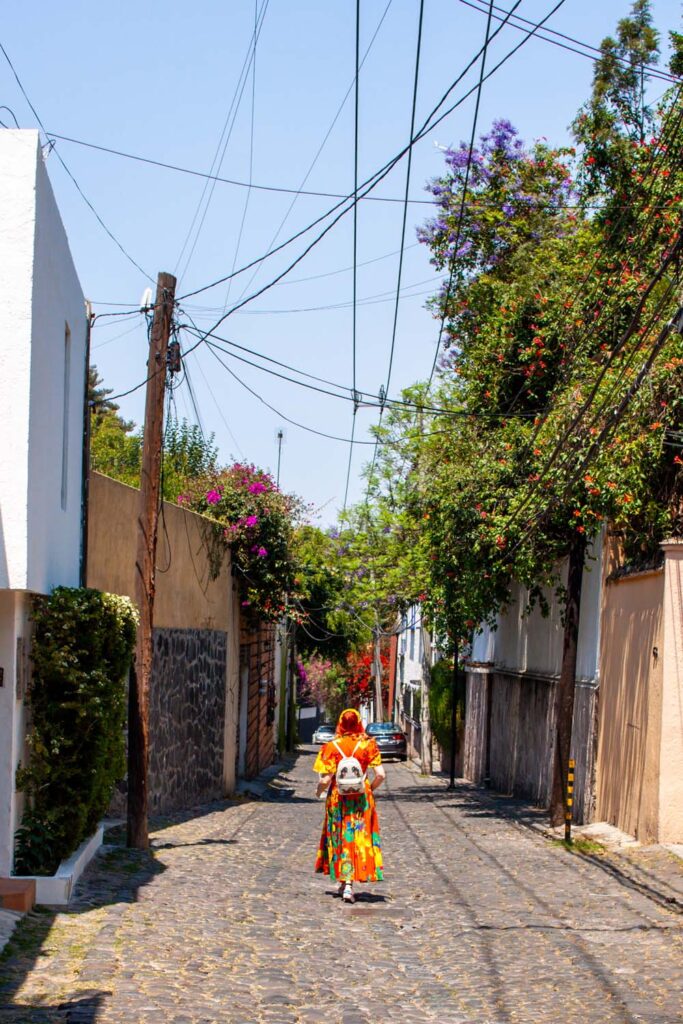
Location & Access
San Ángel is located south of Mexico City, just west of the popular Coyoacán district. Pairing a visit to San Ángel with a trip to Coyoacán is the perfect way to spend an entire day. Away from the crowded city centre and up above all the hustle and bustle. I would advise getting up nice and early for your visit to San Ángel. Nothing starts the day better than brunch at restaurant El Cardenal. Plus an early start means you can get the most out of your day.

Uber
The best way to get to San Ángel is via Uber. Anywhere from the centre of the city, outside busy times of the day, it will only take about 25-30 minutes to arrive here. And generally, a ride will cost around $7 USD. Our first stop on the walking tour is in the beautiful Parque de la Bombilla, so you can put that down as your routed destination.
Metro
If you prefer to take the metro, you can arrive at Miguel Ángel de Quevedo Station. It is only a 10-minute walk from the station to our tour starting point. All metro stations in Mexico City have a different icon corresponding to their station. This was initially conceptualized to ensure that illiterate people could identify the other stations on a map.
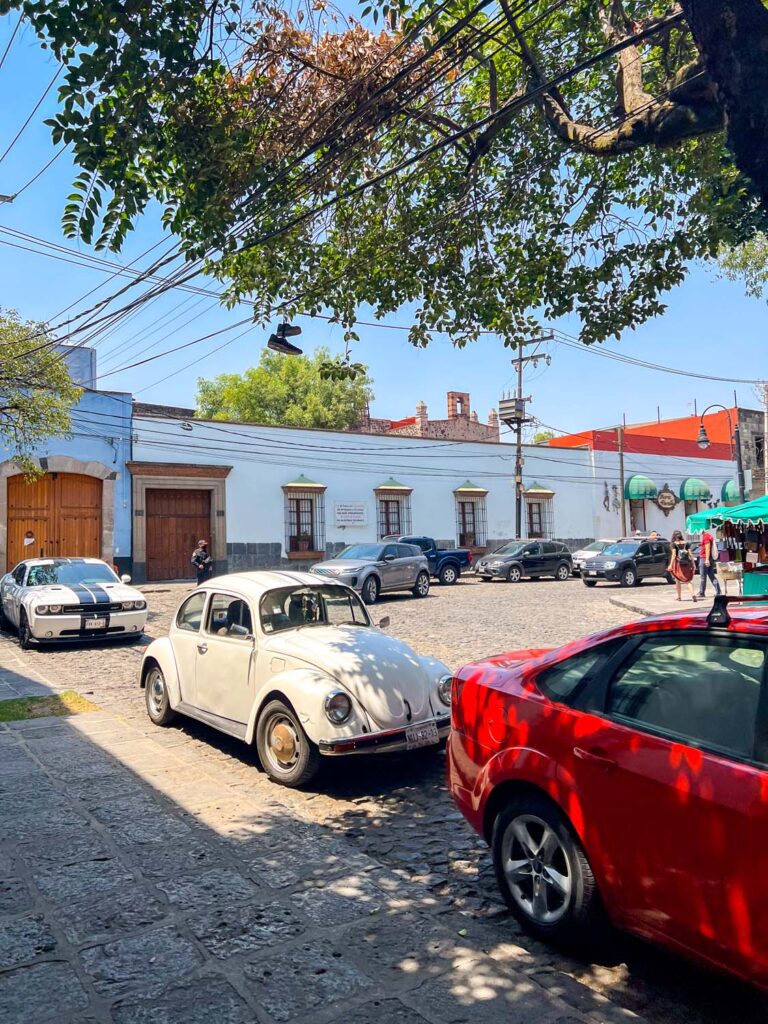

The icon for Miguel Ángel de Quevedo is a large fruit tree. Miguel Ángel de Quevedo was a famous Mexican engineer who studied Mexican flora. He was nicked named the “tree apostle,” hence the station’s icon. But also considering this area was once rich with orchards, it also seems fitting. Just a little hint at the colonia’s history right from the get-go!
History
The neighbourhood, which is now San Ángel, was initially one of the wealthiest agricultural plots in ancient Tenochtitlan. Tenochtitlan was the capital of the great Aztec empire. Here there was an abundant source of water from the nearby Magdalena River. The area was called Tenanitla, or “walled in place,” in the Nahuatl language. The name was inspired by the volcanic rock bed that surrounded the area. It is also called Pedregal, formed by the eruption of the Xitle Volcano two thousand years ago. The volcanic bed formed a kind of wall around the land which helped retain the water from the river.
The Monasteries
When the Spanish invaded, they took the land in San Ángel for their own. It was here they established a series of monasteries. The most important of which was the San Jacinto monastery, which gave the area its first Spanish name; San Jacinto Tenanitla.

The next monastery to be built was the El Carmen monastery, built by the Carmelites in 1597. Inside the monastery, the monks opened a small school. But most of the land surrounding the church was used to plant a large expanse of orchards. The orchards flourished due to fertile soil and access to water. At one time, there were over 13,000 trees that sprouted up around the community. The school and orchards were named after San Ángel Mártir, the first members of the Order of Carmel. People would marvel at the orchards and their harvest would bring in a lot of money to the order and the area. The popularity was such that eventually, people would simply refer to the neighbourhood as San Ángel. And soon that become the de facto name for the area.


San Angel as Retreat
In the 18th century, wealthy farming families began to seek larger plots of land outside of the city center. These families began to build some of the most spectacular mansions. Many still stand today as exemplary models of 18th-century architecture in Mexico City.
In the 19th century, the orchards and many of the religious institutions of San Ángel were destroyed in the Mexican-American War. The remainder of the farming lands and orchards were removed to make room for the expanding railway system in 1891. This left the area barren of all its agricultural potential which had once defined the barrio. While the city centre was building industrial factories, San Ángel remained untouched by progress and left as a relatively rural suburb. But it was just peace and quiet that, in the 1940s made it a popular country retreat for wealthy Mexican families. These families continued to preserve the historic homes they found. And kept the area as this precious gem that we can visit today!

Walking Tour
Your experience in San Ángel will be defined by the day of the week you choose to visit. If you come to San Ángel on the weekend, especially on Saturday for the Art Market, the streets are bursting with people. Car surge into this part of town, as locals love to come here on the weekend in droves. It’s not just for the tourists, in fact, I would say the locals outweigh tourists three to one. But outside of the weekend, San Ángel is a tranquil oasis. And you’ll find you often have parts of the city all to yourself. But the peace means you’ll have to skip the popular pop-up art market. Either way, there are so many things to do here, no matter when you arrive. The only day I’d say to avoid is Mondays as all the museums are closed.
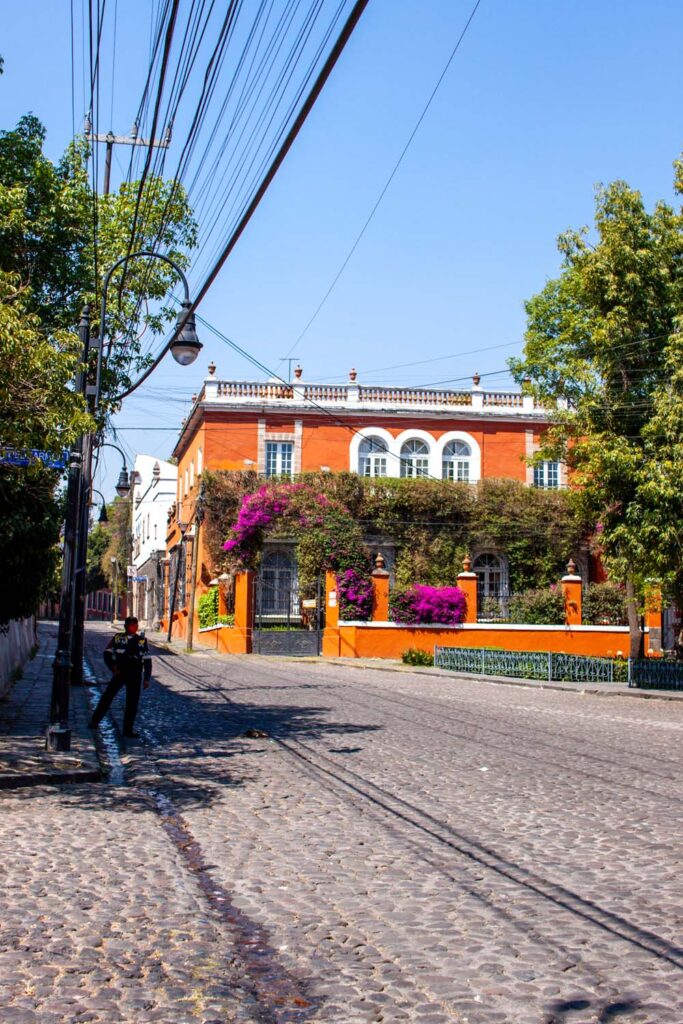

Parque de la Bombilla
The best place to start your tour of the neighbourhood is in San Ángel’s grandiose Parque de la Bombilla. Mexico City is, in my opinion, the best city in the world for public parks. Each of them brings a new surprise. Filled with beauty, drama and artistry. And Parque de La Bombilla is one that I feel doesn’t get its fair due. In the centre of the park is a giant monument to Álvaro Obregón. Álvaro Obregón was the 46th president of Mexico, inaugurated in 1920. Sadly, Obregón was assassinated in 1928 inside La Bombilla restaurant, which once stood on this very spot. After his death, the restaurant was demolished to make room for a park built in his honour. The park’s unveiling took place in 1935, on the seventh anniversary of Obregón’s assassination.

The Obregón monument dominates the park. Towering over you like a lighthouse, drawing you in. A huge reflecting pool sits just in front, allowing the sun to cast its reflection down into the water, creating a mirror-like surface. In addition to the central monument, the park also boasts seven beautiful fountains, artistic garden beds and even various chess and checkers tables awaiting their daily players.
Socialist style architecture
The Obregón Monument is a socialist-style tower. Socialist-style architecture became somewhat of a trend in Mexico City in the early 20th century. Mexico was encouraged by the Russian Revolution of 1917. They admired how the shift was leaning towards the boots on the ground workers and peasants while rejecting the bourgeoisie and upper classes. As such, they were inspired by the architecture of the Soviet Union under the leadership of Joseph Stalin. The style is characterized by rigid, geometric shapes, sturdy columns and giant statues. Often built to commemorate great leaders of the country.
Obregón Monument
The Obregón Monument greets you with two statues, guarding either side of the giant steel doorway. These are the indigenous protectors, representing “Work” and “Fertility.” The monument’s centre features a large stairwell that climbs to the top of the tower. Inside was once the resting place of Obregón’s embalmed arm. The arm was since moved, but today, a marble copy stands in its place.
On either side of the monument, are two groups of sculptures. One represents the Allegory of the Sacrifice, the other the Allegory of Triumph; two defining characteristics of Obregón’s presidency. On the back of the memorial is the sculpture of the great Eagle of Mexico City. Its wings spread in front of a series of geometric Saguaro cacti.
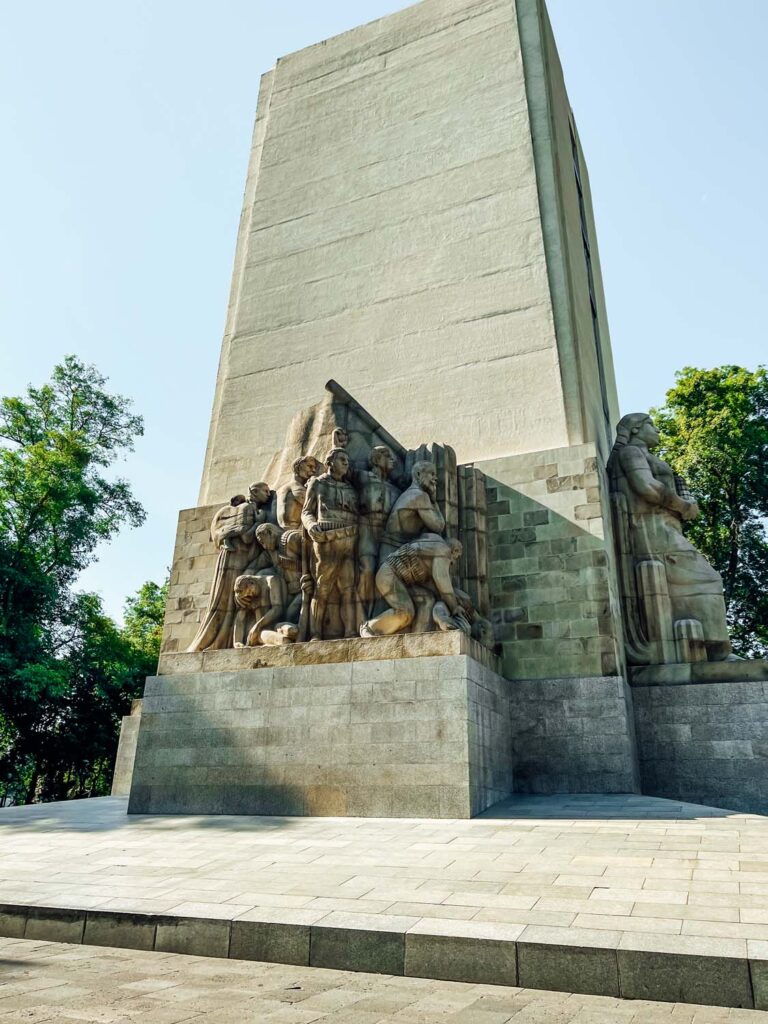
Restaurante El Cardenal
Hopefully, the bright colours of the park have woken you up a bit and now it’s time for breakfast! Take a stroll up along Avenue de la Paz. This street leads you right into the historic heart of San Ángel. Here you’ll shortly arrive at our breakfast spot, Restaurante El Cardenal. Restaurante El Cardenal is an institution in Mexico City with multiple different locations. The San Ángel location is their newest expansion, opening in 2011. But it quickly became the go-to destination on Saturday and Sunday mornings.

El Cardenal History
El Cardenal was founded in 1969, the original location was just across the street from the Plaza de la Constitución. The founders were a large family who wanted to bring their love of traditional Mexican cuisine to an upscale setting. They saw that many households didn’t have time to make classic home-cooked dishes. But here in El Cardenal you can come and feel like you’re dining at your mother’s table.
One of the most luxurious parts of dining inside El Cardenal in San Ángel is the gorgeous architecture. The restaurant is set inside an old colonial mansion. The building was actually previous another restaurant but when it closed the house lay dormant for years. When El Cardenal bought the property they took great pains to restore the details of the home to their former glory. The stained glass windows and gleaming wood floors make just sitting inside such a joy to experience. The back of the restaurant features a glass window box that looks into the kitchen, so you can watch the chefs hard at work!



The El Cardenal Experience
Their breakfasts are among the most popular seatings, with wait times up to 40 minutes depending on the day. So the earlier you arrive, the better. This is because huge families come here all together on the weekend for a cheerful family brunch. Despite the wait, this amazing familial atmosphere is what makes this restaurant so special. Walking inside, we were treated like absolute royalty. White-shirt waiters greeted us and catered to our every need. It felt like we were dining at a Michelin star restaurant but at a fraction of the cost!
The Food
To start the perfect breakfast, begin with hot chocolate, not coffee! Their unique hot chocolate is made with famous Doña Oliva chocolate and is like drinking a cup of history. Hot chocolate originated in Mexico and was an essential part of the Aztec culture from 1400 AD.
My favourite part about the experience of eating here was the pastry tray. When you come inside a waiter brings you over an enormous tray of sweet pastries. And you can choose, with your own eyes, which pastry you’d want to start off the meal right with. I went with the concha as I feel like it’s the perfect pairing with a hot chocolate.
Another traditional breakfast dish you’ll only find in Mexico is the Egg omelette with escamoles. Escamoles are colloquially called “Mexican caviar,” and are edible ant larvae. Escamoles have been consumed in Mexico since the age of the Aztecs and are high in nutritional value. It’s definitely one of the most unique and classic dishes on the menu. But if that’s not your thing they have many other traditional options for those who aren’t that adventurous.
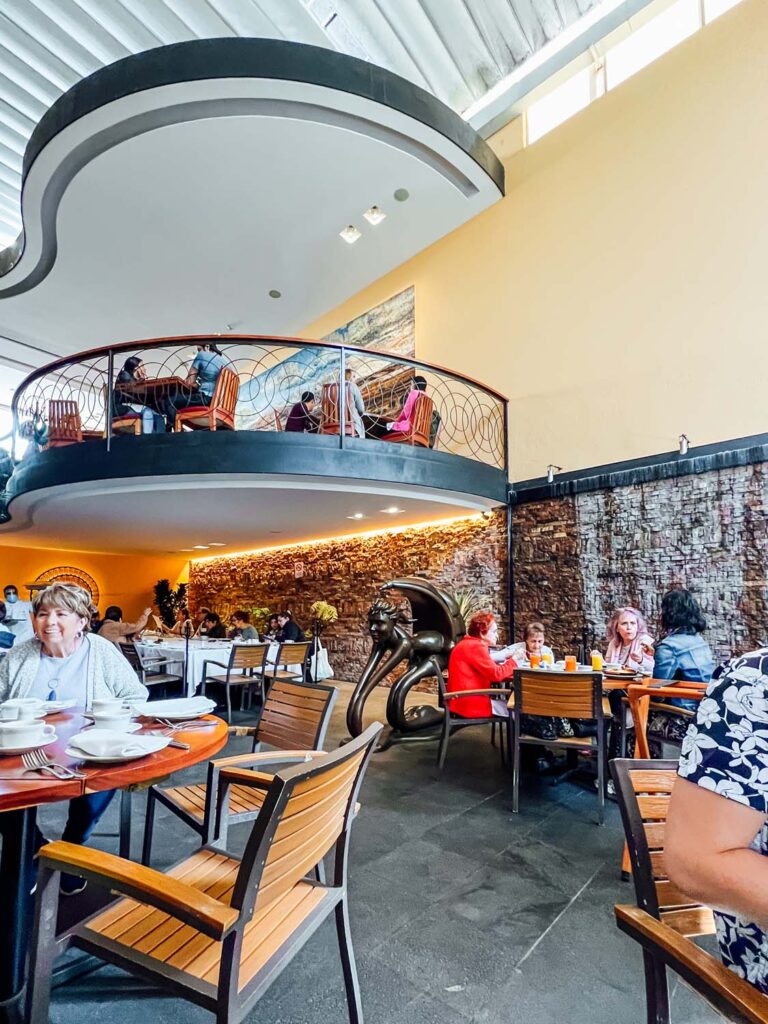

While you might take a look at this elegant restaurant would be pretty pricey, El Cardenal is such a good value. They really price themselves as a family restaurant. Although there were some tourists here it was clear that most people gather here every week. And with food as good and cheap as this, I know why they do!



Mercado De Flores
To work off some of the big breakfast, walk down the street and turn north up Avenue Revolución towards the famous San Ángel Flower Market. This market dates back to the time of the Carmelite friars. When they lived in the area, their church was surrounded by extensive gardens. Here they grew fruit trees and flowers in large quantities.
Walking up to the market, you can spot it from down the street, not only by the iconic white awnings but also by the brightly painted murals along the exterior. Public murals like this were famous in markets like this around Mexico City. Vendors are packed tightly along the thin strip of the sidewalk facing the Avenida Revolucion. In their white plastic buckets are a wide array of vibrant flowers for locals to bring home to their sweethearts with a smile.
Templo del Carmen de San Ángel
After peaking around at the flowers in the market, head back south along Avenue Revolución. Crossing Avenue de la Paz, lead yourself towards the large domes that dominate the skyline guiding you into the old Carmelite Church of San Ángel.

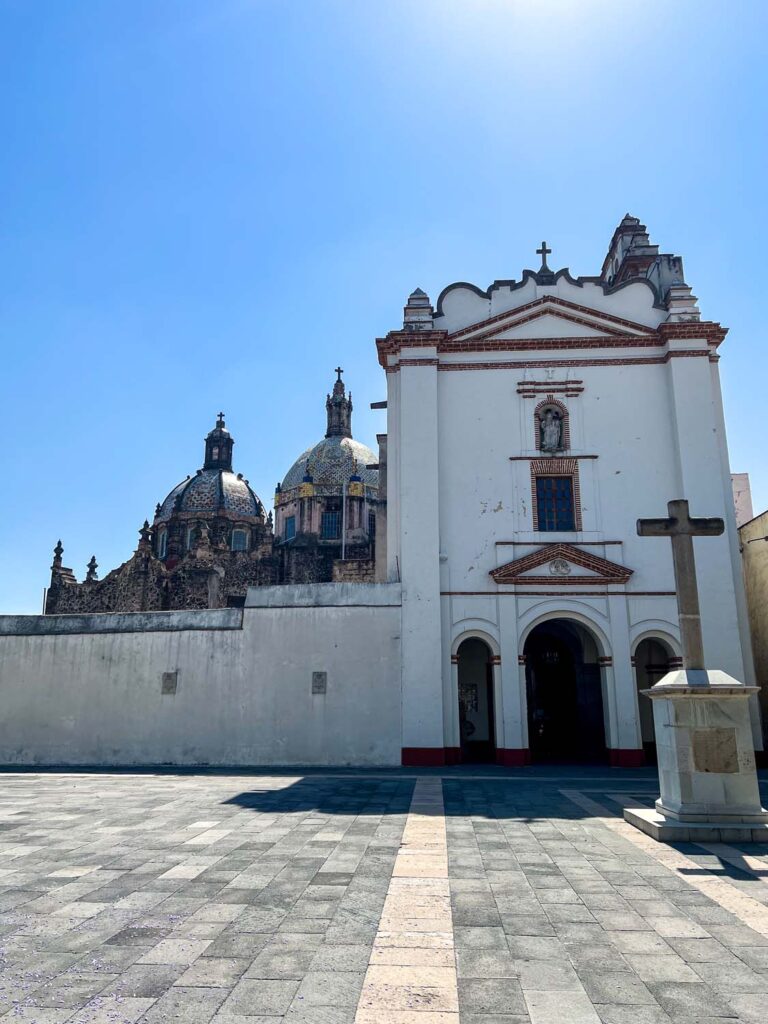

Courtyard
While most people go directly to the Museum of El Carmen, checking out the church itself is more than worth your time. Even just walking through the old stone walls into the quaint courtyard gives you so many things to look at and ponder. The church courtyard is home to one of the most amazing jacaranda trees. Hidden behind the stone walls it feels like a treasure that we found was all to ourselves! It hangs heavy over the fountain in the centre of the stone yard. Its branches also frame the gorgeous tiled domes off in the background.

History of the St. Carmen Church of San Ángel
The church was originally built in 1615 by the Carmelite friar Andrés de San Miguel. It took over 10 years to complete, and when it opened it housed the order of the Barefoot Carmelites. It was originally opened as a monastery but they also built a college nearby. Here they welcomed theology students and new priests of the order. The church flourished for years and its orchards formed the bedrock of the colonial we find today. Bringing both money and interest to this part of town.
After the Mexican Reformation War of 1858, the new secular governmental powers closed down many Catholic churches and schools. The area around San Ángel was occupied by US troops who sadly destroyed many parts of the old buildings. As well as looting many of the church’s precious assets. They even went so far as to destroy the beloved orchards.
The old school building went on to serve as a prison, barracks and even the location of the local town council. Eventually, in 1921, the church school was transformed into a museum. It was here they sought to preserve the history of the building, the treasure found hidden within and the stories from the neighbourhood’s past. But the actual church itself has stood here, in almost the exact same state, for hundreds of years. And walking inside feels like stepping back in time.
Architecture
The design of the church was made in Herrerian style. Herrerian style rose in popularity in Spain during the 16th century and came to Mexico City with the Spanish colonizers. The style features a more restrained use of ornamentation compared to other baroque styles of the time. The shape of the building is designed to spread horizontally and symmetrically. And yet unlike many other Herrerian buildings which have flat or plain roofs, the St. Carmen de San Ángel church features three incredible tiled domes. Brilliant blue and yellow-painted tiles from Puebla still glisten in the sunlight although much of the roofs have fallen into disrepair over the ages.
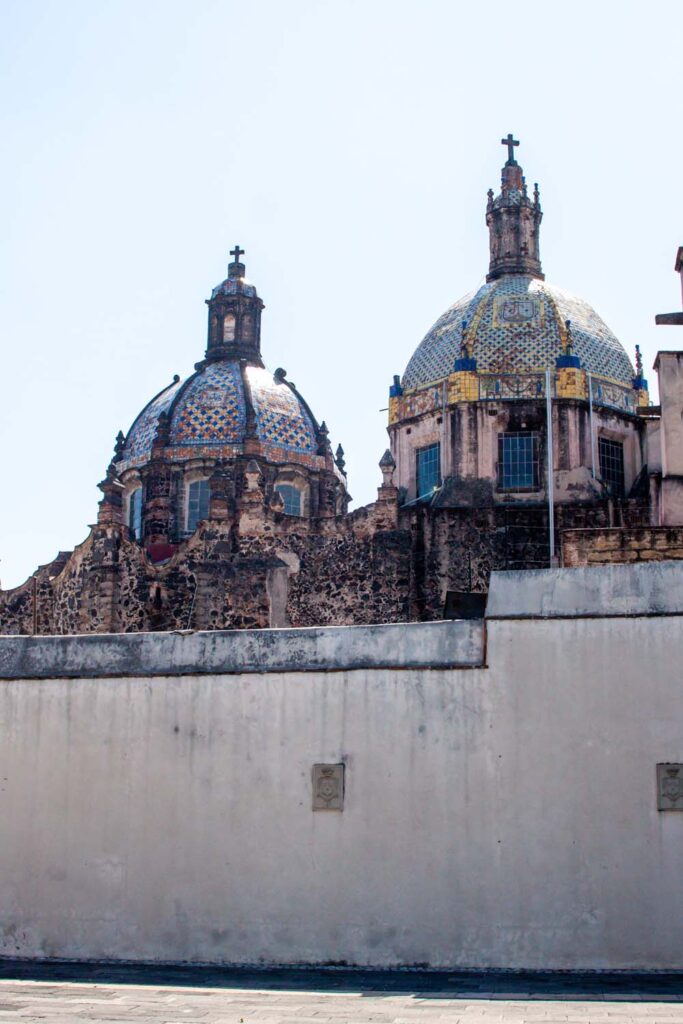
Walking into the church, the restrained architecture that surrounds you highlights the incredible golden altar. Light frames the altar from either side creating the most ethereal glow. While the rest of the building might be simpler in design, the altarpiece is pure baroque. Drama, glamour and gilding are everything that the baroque era brought and we can see it here in leaps and spurts!

One of my favourite parts about the churches in Mexico is the tile work. Every little side chapel or tiny niche is given the royal treatment by plastering them with gorgeous tiles. These minature tiles look like shining gems when the sunlight hits them just right. While some are just decorative others are painted to tell stories about the saints in whose chapels they sit. These tiles truly make Mexican churches feel so unique and gives you a sense of place when visiting.
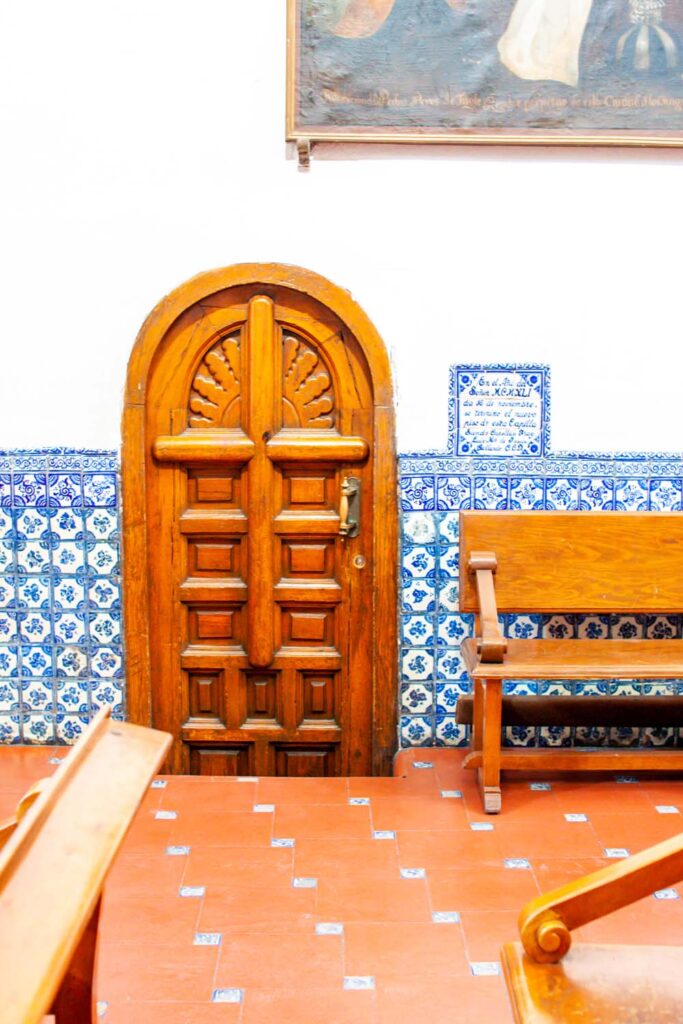


Museo de El Carmen
Just outside the entrance to the church, you can find the Museo de El Carmen. The old monastery school and cloisters were transformed into a museum in the 1920s. Inside, the museum houses various objects that detail the history of the Carmelite order. When you enter through the lower cloisters you’re greeted by a small series of panels detailing the complete history of the convent and school. Throughout the rest of the museum, these histories are brought to life through a series of paintings, documents, sculptures and even the furniture which was used inside the monastery.
As well as detailing life in the monastery, these historical paintings also depict what life was like in San Ángel in the 18th and 19th centuries. It features an amazing collection of Colonial religious art. The baroque artist Cristóbal de Villalpando has many paintings here on display. He is most famous for his painting which now hangs in the Metropolitan Cathedral. But inside this more intimate museum, you can view his pieces close up and see them in a more personal light.
The Crypt
One of the most interesting, or for some, macabre parts of the museum is the old crypts. When the monastery was a working church, many people would pay to be buried in such a holy place. These were both members of the Carmelite Order as well as wealthy benefactors.
But over the years, and after the fall of the religious institutions, many of these bodies were forgotten. Only in the 20th century were they uncovered during the monastery’s restoration. The bodies left here were miraculously preserved because of the rich soil by which they were surrounded. They were essentially mummified. With no one to claim the bodies, the museum decided to leave them where they rested, and now visitors can give view their wrinkled flesh up close and personal. Preserved for the ages inside their velvet-lined wooden and glass caskets.
Hours & Admission: 52 pesos | Free on Sundays, closed on Mondays
Plaza del Carmen
Head back to the main intersection at Madero and the Avenue de la Revolution to cross over to Plaza del Carmen. The brilliant-coloured buildings that surround the square blend in amongst the vibrant flowers in the garden beds in the middle of the plaza. While the Plaza de Jacinto might be the larger and most popular square in the city, Plaza del Carmen is by far my favourite. Its quaint and cramped quarters are so joyful, with locals sitting out on the benches, chatting with friends, in the early morning. Watching the artists set up their canvases as the sun rises.

San Angel Art Market
On Saturdays, this is where the start of the San Ángel art market can be found. One of the most wonderful things about the San Ángel art market is not just for tourists. Unlike some more touristy markets around the city, this market is meant for the locals. And many people come here, from far and wide, in search of the perfect art piece for their home. The atmosphere is intoxicating, everyone admiring the newest art pieces from their favourite local painters. Rainbow-coloured umbrellas dot the skyline, protecting fresh paint from the harsh rays of the sun.

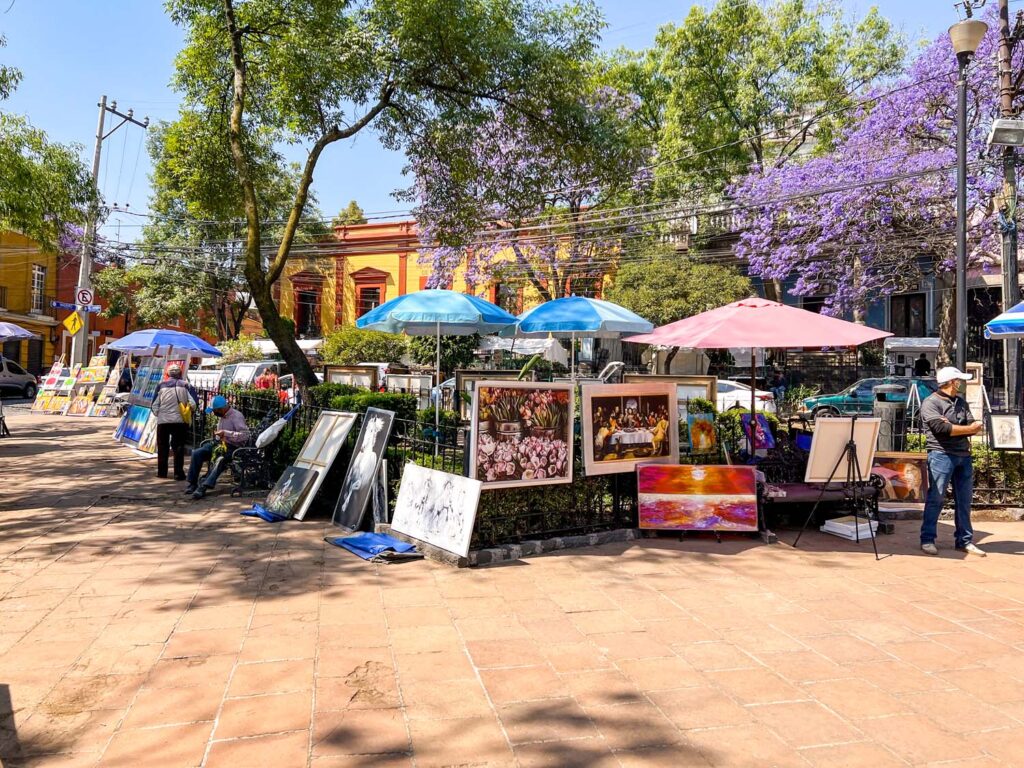


Architecture around Plaza El Carmen
Even if you don’t come on a weekend, this small Plaza is a wonder to behold. It is surrounded on all sides by incredible historical buildings, important to the neighbourhood’s history. Even in just this one square, you can get a slice of the wonderfully preserved architecture that makes this neighbourhood such a gem to visit. Examples of baroque, neoclassical and neocolonial houses can be found right here. And many have been perfectly preserved since this part of town managed to escape the urbanization of the city’s centre.

House of Chucho el Roto
To the southeast, you’ll see a brilliant yellow building with bright red trim on the corner. This is the old House of Chucho el Roto or House of The Two Courtyards. This building is a wonderful example of Mexican neoclassical styles popular during the Protofio Diaz era. The house was named because it was designed with two courtyards, a lavish expense at this time. The main courtyard was built to entertain and house splendid gardens. The secondary courtyard where the carriages and stables were placed. This allowed the home to separate the working part of the house from the relaxing retreat these country homes aimed to create.
Chucho el Roto
The house was built in the 19th century for the philanthropist Francisco de Urquiaga. A popular legend about this home states that it was the hiding place for the famous bandit Jesús Arriaga. Arriaga was also nicknamed “Chucho el Roto,” hence the other name for the house. Arriaga was somewhat of a Robin Hood-type character, robbing from the wealthy and giving to the poor. This house was reported to be connected to the underground tunnels built by the Dominicans. The tunnels could be accessed through the basement and led to the nearby Plaza San Jacinto. Making it a perfect getaway for a legendary bandit.
Sadly, Arriaga was eventually captured and died in prison. But his legend lived on long past his death. And fictional stories became even more popular after his passing. Today it houses the Library of the Revolutions of Mexico. Very apt, considering it was the hideout of this legendary anti-establishment character who would have been a staunch supporter of the revolutions.
Mercado del Carmen
On the north side of the Plaza sits the popular Mercado del Carmen. This hip communal-style eatery and art gallery are housed in an old mansion dating back to the 18th century. It was also used as an English school for the upper classes of San Agnel during the 1960s and 70s. The gorgeous blue of the house blends in almost perfectly with the sky on a clear day, making it feel at one with heaven above.
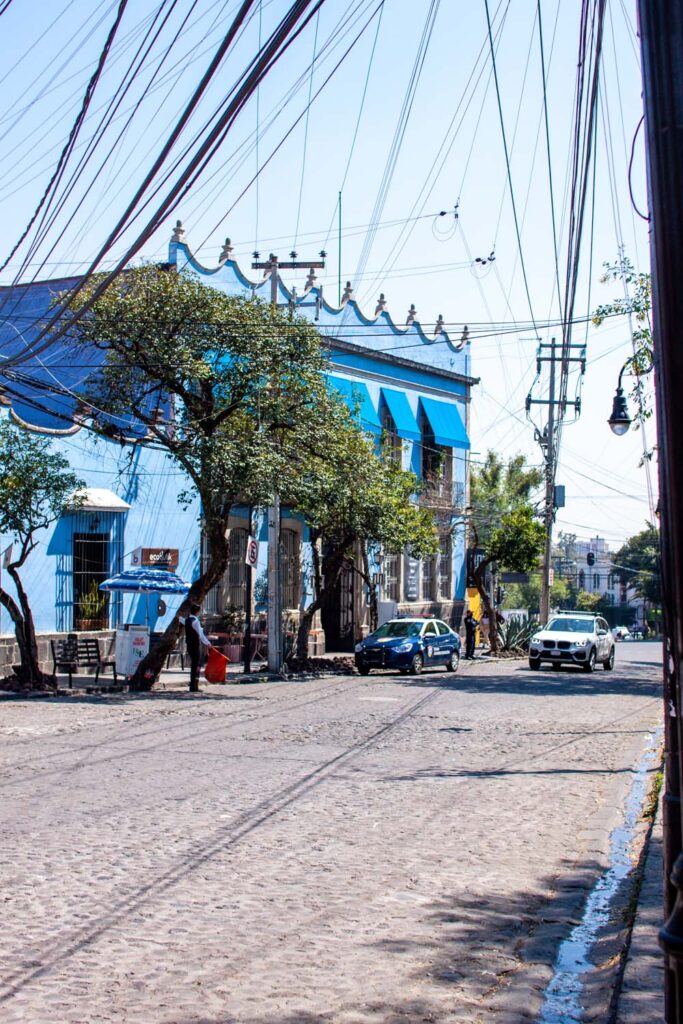
Casa del Mayorazgo de Fagoaga
On the northwest corner of the plaza, along Calle de la Amargura is the Casa del Mayorazgo de Fagoaga. The brilliant burnt orange exteriors and 18-century facade welcome you onto one of the most luxurious streets in the city. It was designed in the neoclassical style with baroque-style balconies.
The home was originally built for Francisco de Fagoaga, the head of a powerful silver and gold merchant. His family was one of the first to start the trend of moving their mansions out of the central city and into the countryside. His house set the tone for other wealthy haciendas built in the era and unsurprisingly lots of future houses follow the same template. It was truly a trendsetter. The orange contrasts so well with the dense green foliage and pink flowers that bloom across the facade.

Bishop’s House
Continue along Calle de la Amargura towards the end of the street, blocked by the corner of the old Bishop of Tenagra’s mansion. Joaquín Fernández de Madrid y Canal served as the Bishop’s adobe here in San Ángel. A Bishop was a highly regarded figure in the community. As such, the friars wanted to build a house that would impress! His house was built in 1631 (!) and is one of the best-preserved pieces of history in San Ángel. Long after the revolution, the house still stood as a well sought-after real estate piece. It was home to various famous Mexican like poet José Zorrilla, historian José María Agreda and politician and general Antonio López de Santa Anna. Today, the house serves as an art gallery hosting rotating exhibitions featuring incredible Mexican artists.

Plaza San Jacinto
Turn south past the Plaza Tenanitla (dedicated to the original name of the colonial) and make your way into the grand Plaza San Jacinto. The Plaza was named the Church of San Jacinto, located just on the west side of the square. But we’ll learn more about the church later when you go inside. The little town square popped up here as it was surrounded on all sides by the church, convent and orphanage. It quickly became the heart of the community in the 18th century and continues on as such today!

St. Patrick Battalion
On the far west side of the Plaza, on the wall opposite, you’ll see a large plaque dedicated to the St. Patrick Battalion. “Why is there a dedication to Irish soldiers in Mexico City?” you might be wondering. In 1847, during the Mexican War for independence, Irish, German and even American immigrants came over to Mexico. They wanted to help fight for Mexico’s freedom, against the United States. The battalion was one of the fiercest and responsible for a huge majority of the deaths on the American side. So when they were caught, their punishments were brutal. They were executed right here in San Jacinto square, in front of the famous church. But their legend lives in on this plaque stands in their honour. The memory of their fighting vigour an inspiration to others who would continue the fight and win the freedom of the nation.
Diego Rivera
Make your way to the centre of the Plaza and look across the elegant central fountain. There, you will see a bronze easel with the burst of Diego Rivera emblazoned into the cartouche. As Rivera was a resident of the San Angel for many years, local artists inspired by Rivera wanted to commemorate him for generations to come. There is something wonderful about Rivera’s face looking over at the artists in the square selling their works in the square. Continuing his passion for supporting Mexican artists, even from the great beyond.
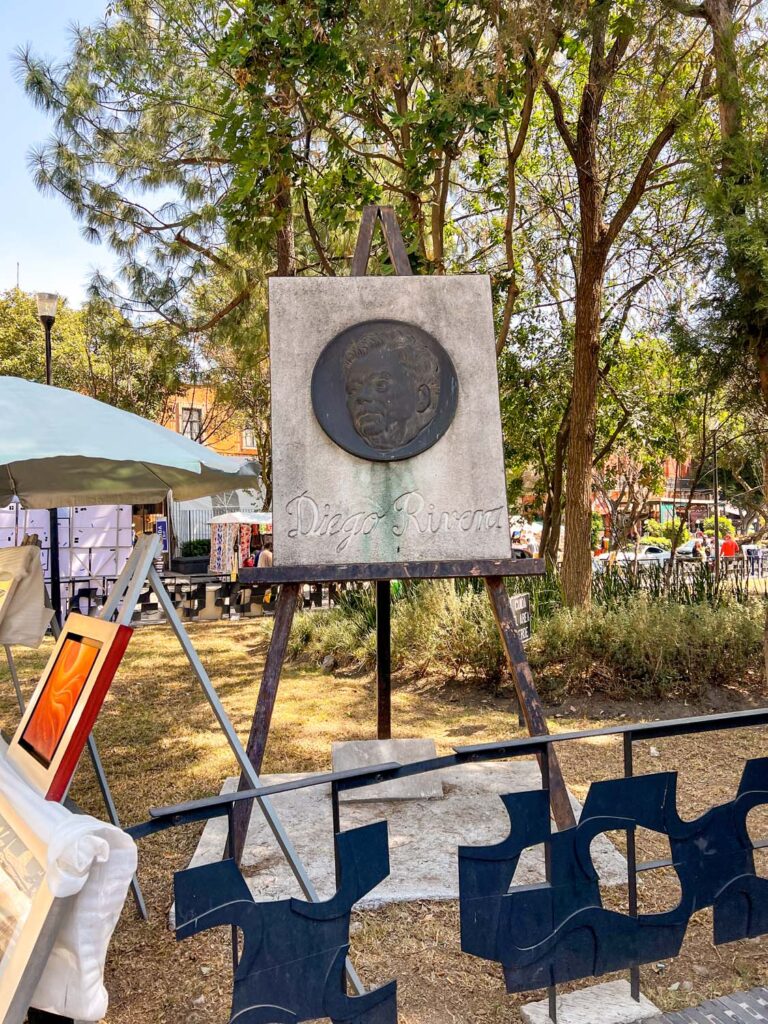
Saturday Art Market
By far the most popular thing to see in the square is to peruse the incredible Saturday Art Market. The market was established here in the 1960s. Interestingly enough, the origins of the market were due to an American, Jim Tillet, who had moved to Mexico City. He brought the concept of a weekly artisan fair to Mexico City, and the idea immediately took off. The art is both meant for the locals to enjoy as well as the tourists, highlighting the beauty of the Mexican landscape and vibrant culture. There were so many amazing artists of all different styles and mediums. My favourites were the ones that were designed to look like Lotería cards.
In addition to paintings, this Plaza is also home to craftspeople. Here you can find artisan pottery, textiles and even clothing. While some of it is a bit touristy things there are also really unique designers and artists. Prices tend to be a little more expensive here in San Angel but the quality is there to match.


There are often musicians strolling around through the market, entertaining the crowds and creating a more inviting and charming atmosphere. Street food vendors pop up selling sweet treats and salty snacks to satisfy your cravings. Art hunting is hungry work!
Handicraft Shops
If you opt to visit San Angel outside of the weekend, you can still find lots of different handicraft shops open around the square throughout the week. Shops like the Bazar San Ángel, María Bonita and Local México all sell gorgeous handmade decor and art pieces for your home. The spirit of the art market lives on long past the weekend so don’t feel like you’ll have missed it all if you can only visit during the week.
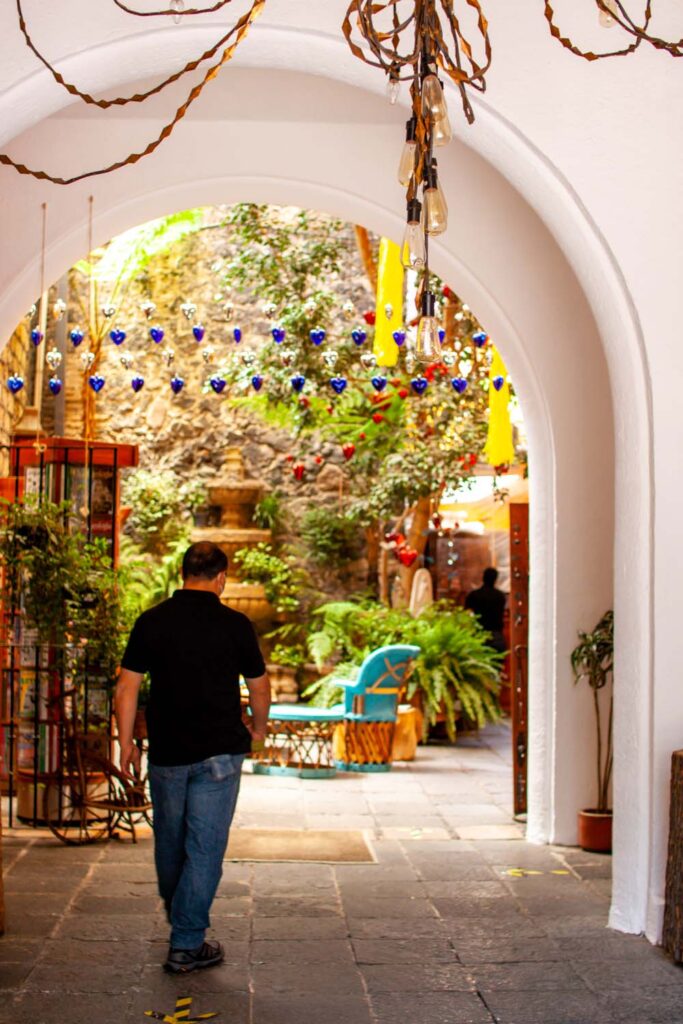

Museo Casa del Risco
On the north side of the Plaza Jacinto, hidden behind the opulent trees, is an old terra-cotta-coloured building with ‘Museo Casa del Risco‘ emblazoned in brass along the fence. Inside you’ll find an old residence dating back to the 17th-century that has since been transformed into a museum. The museum recreates the look of a traditional San Angel house as it would have looked in the 18th century. Casa del Risco has a fascinating history as it served as a residence, a military barracks and a hospital.

Fuente del Risco
The house’s main feature that people come to see is the great porcelain fountain. The fountain, or “Fuente del Risco,” is located inside the main central courtyard. It was made in the late 18th century in the opulent Baroque or “ultra baroque” style popular in Mexico City during that period.

While it looks like it is merely decorative, the fountain’s design was actually an ingenious way to preserve broken porcelain. Back then, painted porcelains were extremely expensive and yet, just like today, accidents happen and you might end up breaking a plate that costs more than a used car does today. Turning them into an art sculpture like this was a way to preserve and display even the broken pieces.
Embedded within the fountain you can spot Chinese blue and white porcelain, plates from the Ming Dynasty, green porcelain from Japan, Spanish Talavera ceramics and, of course, the homegrown ceramics of Puebla. Entire bowls, plates, cups and sauces are also scattered together with broken pieces of pottery to create this magical-looking fountain. The niches are designed to look like pearlescent shells and conches and the piece is dotted with mermaid sculptures. Even here in the hill of San Angel do we find people dreaming of the ocean.



There is so much else to see inside the museum, from Baroque art, religious sculptures, antique stained glass and recreations of 18th-century living space. But if all you want to see is the fountains, it’s easy to do so as admission to the museum is free.
Admission: Free | Open Tuesday-Sunday 10 am – 5 pm
Antiques Fair
On the weekends, just outside the museum, you’ll find high-end vintage and antique sellers bringing out their wares. This was almost as incredible as the museum itself, it felt like just outside you could literally buy items you’d just seen inside the museum. Paintings from the 19th century, religious objects and gorgeous pieces of antique jewellery. The prices are pretty high but even I was almost swayed into buying a locket from 1898! There are some real treasures so if you have the money to spend you’ll discover some amazing pieces in this marketplace.




Bazaar Sábado
If you don’t like sifting through the pop-up stands outside in the plaza, you can head into the Bazaar Sábado. The Bazaar Sábado is located inside a 17th-century red-painted mansion and dates back to the 1960s. Here you can find the giant home filled with over 100 permanent artisan shops selling everything from textiles to jewellery, ceramics and metalwork. Many of these craftspeople are award winners, so their prices are going to reflect that status, but the work is unparalleled. Personally, I prefer the stuff found on the street, but if you’re looking for something more upmarket, this is the place for you.


Inside the central open-air courtyard is a wonderful eatery serving up traditional breakfast and lunch street food. It can get pretty busy right at 12 pm but if you prefer to eat a bit early or late you’ll find more tables open. The food here is wonderful and a great place to try some amazing street food like Tlacoyos, quesadillas and gorditas.



Villa San Jacinto
If the Bazaar Sabado courtyard is too busy you can hop across the Plaza and make your way to the stunning courtyards of the Villa San Jacinto. This 19th-century house has been preserved and transformed to be enjoyed by present-day visitors. The Cafe de las Artes is a gorgeous little eatery inspired by the architecture of the Porfiriato era. Walking up the stairs, you are greeted by this incredible grisaille style stained glass window, bohemian lamps and the Catalan vaults.
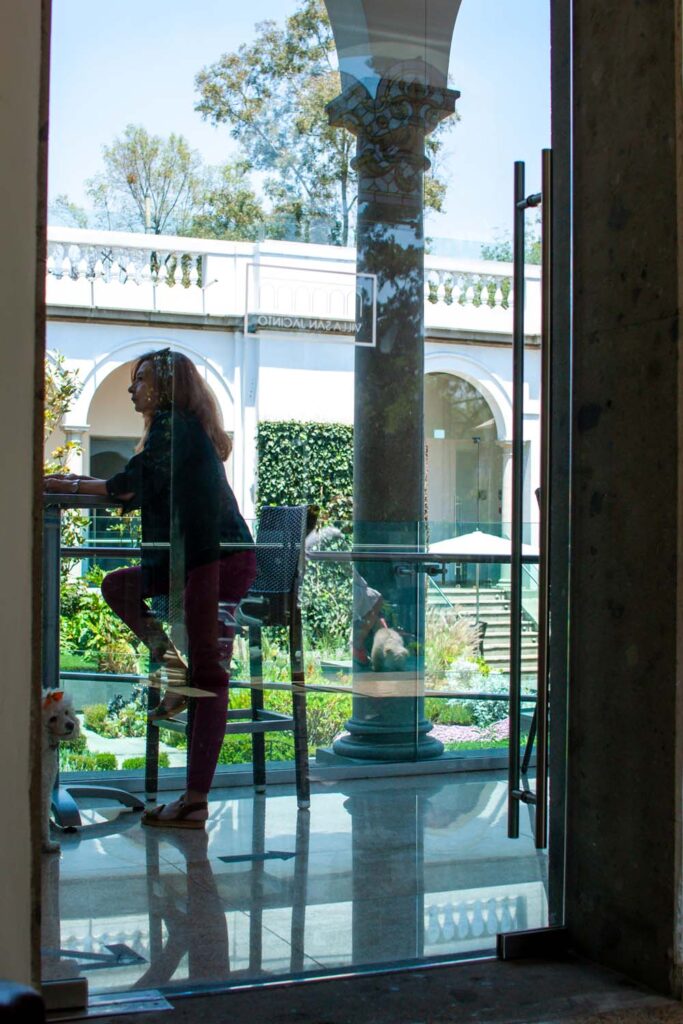

You can also study the amazing remodelled garden filled with beautiful sculptures. The cafe sells lots of different drinks and has homemade desserts and sandwiches if you’re feeling a bit peckish. Sitting outside you can get pretty hot but is a beautiful place to admire the rotating selection of art work on display.

Parroquia San Jacinto
Heading back onto Calle Benito Juárez, walk just a few meters where you’ll find an unassuming set of stairs which leads you into the green oasis outside of the Parroquia San Jacinto. The Parroquia San Jacinto or San Jacinto Parish was founded by the Dominicans in 1564. The Dominican order had discovered a small waterfall nearby and utilized the water to power their spinning and weaving equipment. This allowed them to produce lots of different kinds of textiles. They sold them off and used the funds to fund the building of the church and the plush gardens.

Walking inside the church, the thing that immediately catches your eyes is the ornate churrigueresco-style altar. The rest of the interior of the church is pretty austere but there is something so charming about the simplicity. Be sure to poke your head around the cloisters inside the church. This is the perfect place to escape the sun for a minute and walk through the shaded walkways and central fountain.



The Garden
The contrast between the rather subdued building and the incredibly bright colours of the gardens is a wonderful pairing. In the centre of the garden is a fountain with a huge cross in the centre. This was the first cross ever carved in Mexico. Looking closely at it you can see elements from both the Christian and Pagan faiths.



Surrounding the church are cedars, eucalyptus and pine trees. I always feel like this little hidden away yard is most reminiscent of the old orchards of San Angel.

Plaza de Los Cielos
Walking back outside, take a stroll down the Calle Benito Juárez towards the Plaza de los Cielos. This little corner is a gem of the colonial-era architecture that remains in this neighbourhood. Beautifully decorated in ancient jacaranda and vibrant bougainvilleas pour over the stone walls. The little Plaza de Los Cielos is surrounded on the two sides by the old walls of the former monastery.

Plaza de los Arcángeles
Continue north along Árbol street, turning left on Segunda Cda. de Frontera, where you’ll discover one of the most peaceful yet stunning streets anywhere in Mexico City. The walls here are covered in foliages, and when they bloom in bright purple and blue, it feels like walking through a tunnel of flowers.
At the end of the street, you’ll find the secret Plaza de Los Arcángeles. A nook tucked into the neighbourhood’s corner features a series of benches under a series of stone arches. In the centre of the small gardenette is a shrine to the Virgin of Guadalupe tucked inside the hole of a tree. The name of the Plaza comes from three large sandstone benches named after the Archangels; Gabriel, Rafael and Michael. It’s a fantastically peaceful place and well worth the three-minute detour!
Casa de Los Marqueses de Selva Nevada
Walk back up Arbol and west along with Calle Hidalgo. On the northwest corner is one of the more historic homes of San Angel. Casa de los marqueses de Selva Nevada was owned by Ana Ortiz de Móxica in the end of the 18th century. It would later go on to the owned by María Josefa Rodríguez de Pinillos, the ambassador of Austria-Hungary in Mexico. Maria is responsible for the majority of the renovations we can see today. One of the most impressive parts of the building is the gorgeous wooden gates set between the beautiful white painted trim and ochre-coloured exterior. The door was designed with traditional elements of Mudejar decoration.
Casa Blanca
Continue along the Calle Hidalgo until you reach the large white house at #43. This is called the Casa Blanca, or “white house,” a 17th-century hacienda owned by the Oploca counts. Look closely at the coat of arms above the door to see the design of this family’s old shield. During its life in San Angel, the house was once home to the second-largest orchard in the neighbourhood. All hidden away behind the beautiful parapets of the white house. A small plaque on the front of the house honoured it as a place of historical significance. During the Second Franco-Mexican War, this house served as a bunker for French and American soldiers.
Legen of the Casa Blanca
But the most significant thing about this house is the legend that goes along with it. If you walk slightly further away from the front door, you’ll see a large wrought iron balcony towards the back of the house. The story goes that the woman who once lived here had the love of her life go off to war. She watched him leave from this balcony and would return to it every day, waiting for his return. But he never would come home, and she died an old woman, standing on the balcony, heartbroken. Eternally waiting for her true love to come home. Her ghost is said to still haunt the upper balcony so keep your eyes peeled for her wailing cries.
Licenciado | Leandro Valle
Continue down Hidalgo until you reach Licenciado street and walk north. This is another fantastic example of just how amazing even the ordinary homes in this neighbourhood are. Walls are dripping in ivy and each new facade is painted in a different vibrant colour. Rich wooden doorways and fantastical wrought iron gates protect entry from the street into the secretive homes inside.

Although there might not be any specific historical sights here, these are the streets that make visiting a neighbourhood like San Angel so worth it! The road curves to the right and turns into Leandro Valle. Eventually, popping you outright outside Avenue Altavista. Bringin you to the front steps of the famous Casa Estudio Diego Rivera and Frida Kahlo.


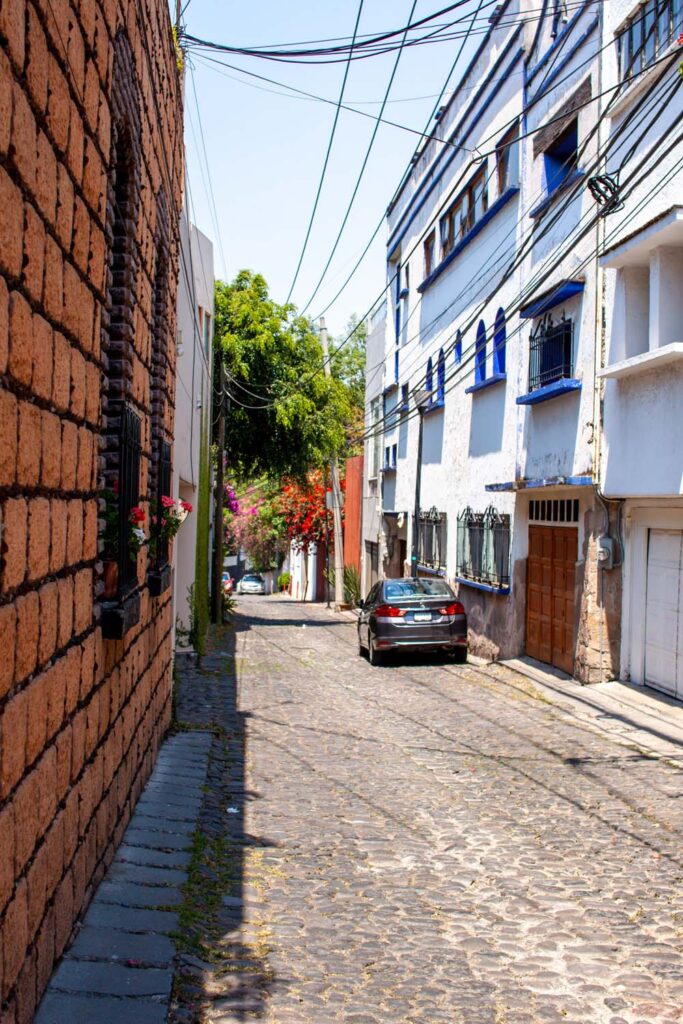
Museo Casa Estudio Diego Rivera and Frida Kahlo
Standing from across the street is the best way to introduce yourself to this famous home. You can see the red and white building on the right, which served as Diego Rivera‘s studio contrasted by the bright periwinkle painted studio for Frida Kahlo. The two homes are connected via the large walkway on the top floor. The entire design of the homes is symbolic of their love. Two very different artists and lovers that are yet forever connected. This was Rivera’s dream home that he had commissioned by architect and friend Juan O’Gorman. O’Gorman is well known for many different famous buildings in Mexico City including the incredible designs inside the UNAM campus.

The museum leads you through both houses to see their studios, living spaces and a gorgeous rooftop view across the neighbourhood of San Angel. To get a complete guided tour of the Museo Casa Estudio Diego Rivera and Frida Kahlo you can read our full guide here.



San Angel Inn
To end your day in San Angel, head back across the street and to the historic San Angel Inn. In my honest opinion, the food isn’t the best here. It was probably one of the most disappointing meals I’ve had in Mexico City. And for what you get, it’s overpriced. But that being said, nothing can compete with this restaurant’s history, decor, and architecture.


My recommendation is to arrive before or after their lunch or dinner rush. And opt for only a drink and perhaps a dessert or snack. This way you can still enjoy the incredible environments but don’t need to worry about spending too much on subpar food. Plus, our margaritas were some of the best we’ve ever had so there are some definite gems to be found!



History
The best way to describe this place is an institution. The building itself dates back to 1616! It was originally the Our Lady of Santa Ana Monastery, built by Hernando Aragonés. Surrounding the monastery was a series of superb orchards and rich agave gardens. They produced a large amount of pulque here over the years, an iconic drink found only in Mexico. Despite changing hands many times over the years, much of the original gardens have been preserved to enjoy today.


History of San Angel Inn
In 1777, the old monastery was purchased by Ramon Goicoechea, who converted it into his family mansion. The hotel was also owned by musician Carlos Prieto who hosted classical music concerts inside. Even today, this tradition continues with live music played throughout the restaurant. Many years later, in 1908, the property was transformed into a large hotel and restaurant. The new owners sold off the excess land, which turned into the neighbourhood of Altavista. The huge mansion was divided up to make all different spaces, from guest rooms to the various restaurants and event spaces we can visit today.

Walking through the hallways, courtyards, and different rooms feels like being inside a living museum. The walls are covered in artworks collected by all the different owners who called this place home over the years. Famously, this restaurant was so popular that it was even notable for hosting various Mexican revolutionaries from Emiliano Zapata to Pancho Villa and Zapata. They were even seen singing a unity pact right here in the restaurant!


This brings us to the end of this incredible tour of San Angel. I hope you’ve enjoyed the sights we’ve seen along the way. Let me know in the comments which stop was your favourite or other treasures you’ve discovered along the way!
Happy Travels, Adventurers





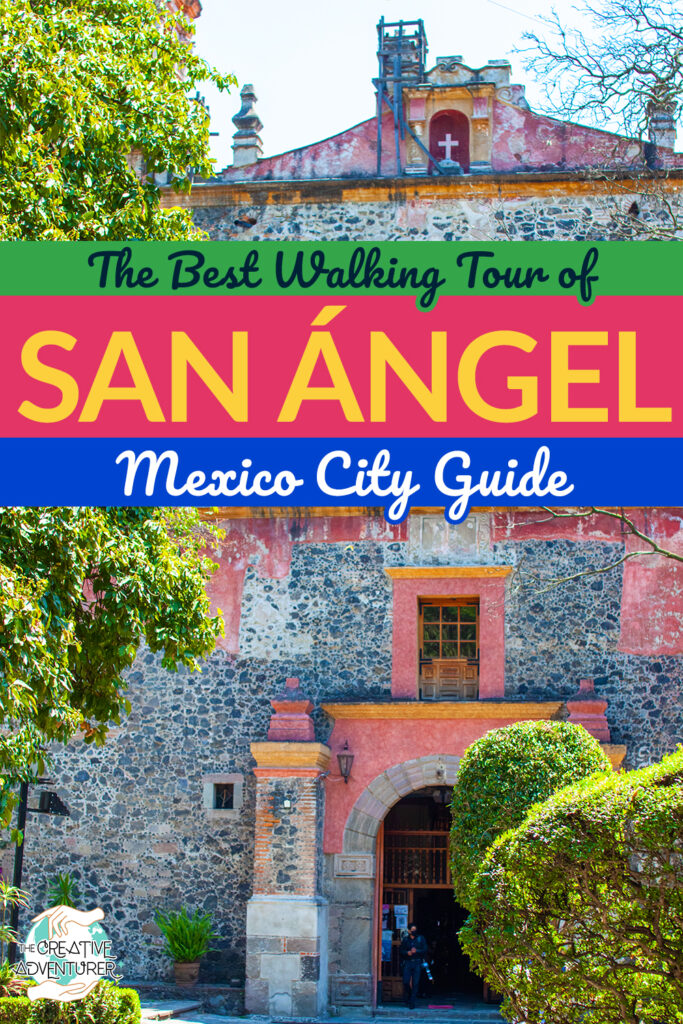

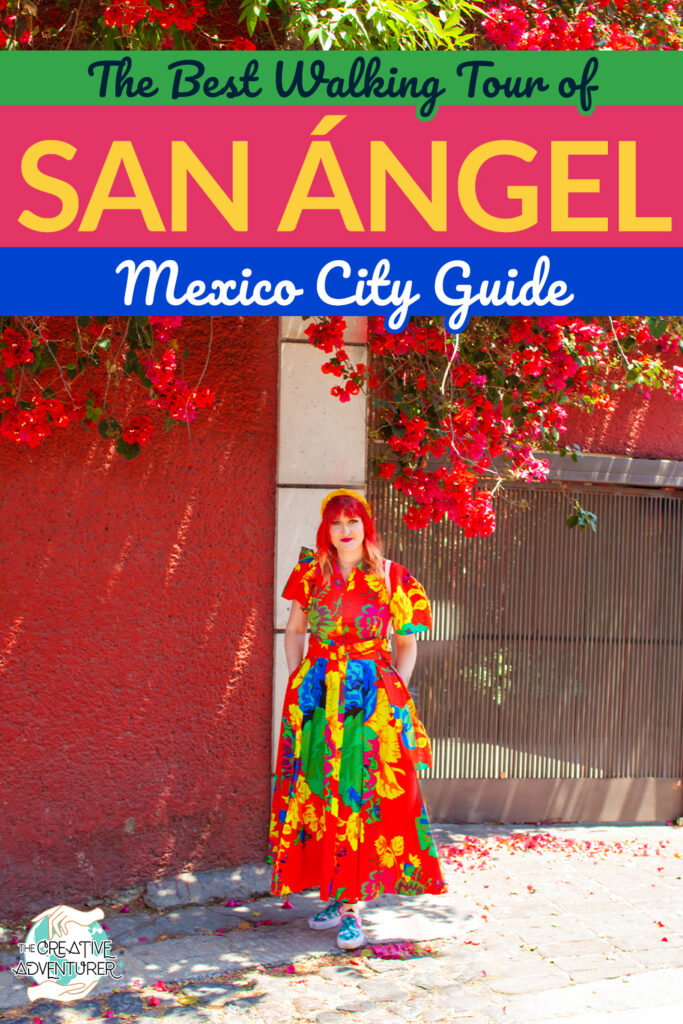









 (@bkbarbosa15)
(@bkbarbosa15)



4 COMMENTS
Ariane
1 year agoSo glad I found your website and blog. This guide to San Angel was invaluable! We visited on a Monday so missed the crowds. Our favourite parts were the San Jacinto church gardens and wandering the beautiful little cobbled streets.
The Creative Adventurer
1 year ago AUTHORThat’s amazing! I’m so glad you had a lovely time. San Angel is so different on the week compared to the weekends but I also find the peace absolutely entrancing. Thanks for leaving such lovely feedback. I get such a kick out of hearing about other people’s experience in my favourite city
Deb
11 months agoYour guide was so well done and we thoroughly enjoyed using it to explore. Thanks for your research!
The Creative Adventurer
11 months ago AUTHORThanks Deb! I loved writing it for you!